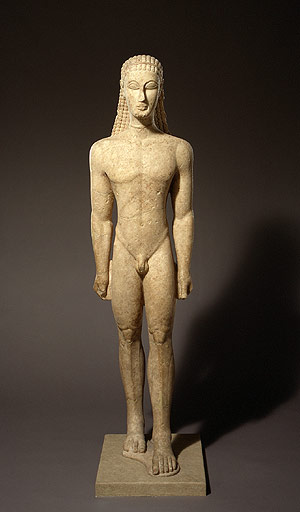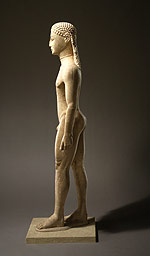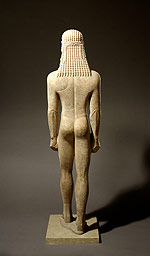
ARTH232  SPRING 2016 SPRING 2016  SCHEDULE SCHEDULE  REQUIREMENTS REQUIREMENTS
|
ARCHAIC SCULPTURE
New York Kouros
said to be from Attica
Marble, Height 6 feet
c. 600 BCE
(Metropolitan Museum of Art, New York)

The kouros in the Metropolitan Museum in New York, made around 600 BCE, shows
the Greek appreciation of the natural symmetry of the human body with its pairs
of eyes, ears, arms, and legs. The sculptor has stressed this symmetry by
keeping the figure upright, facing straight forward, and standing with its
weight equally distributed on its two legs; avoids any twisting, turning, or
bending. Besides symmetry about the vertical axis, there is also an attempt to
maintain a symmetry about a horizontal axis. Two horizontal axes imagined -
one through navel, and the other across upper chest - with symmetrical designs
produced on either side. The repetition of shapes produces a decorative
pattern, which is continued in details, such as in the curves of the eyebrow
and eyelid, the shapes at the knee caps, and at the elbows. The natural
divisions of the body clearly marked
 
The body is abnormally proportioned - maintaining the four-square character of
the original block. The anatomy is summary - muscles and bones being indicated
or implied by lines (grooves) on the surface. The head is cubic with a long jawline and unrealistic eyes and ears. The eyes are large and flat without tear-ducts, while the mouth is represented as a straight line. The hair rendered in a series of connected globules, secured by a band knotted at the rear and descending in a symmetrical fan over the back.
Except for a neckband, the figure is naked. Male nudity need not cause
surprise, since in life men appeared naked in the gymnasia. But there is
probably more to it than that. Although it is often stated that no other nation with which the Greeks came into contact allowed male nudity, the following Egyptian statues indicate that this was not entirely true.

Snefru-nefer Standing
Late 5th Dynasty (2465-2323 BCE). Painted limestone. Hight 78 cm (c. 11 inches)
(Kunsthistorisches Museum Ägyptisch-Orientalische Sammlung, Vienna)

Merye-Ha-Ishetef
6th Dynasty (2323-2150 BCE). Painted cedar wood. Hight 65.5 cm (c. 26 inches)
(Ny Carlsberg Glyptotek, Copenhagen)
|
© Christopher L. C. E. Witcombe
|

 SPRING 2016
SPRING 2016  SCHEDULE
SCHEDULE  REQUIREMENTS
REQUIREMENTS

 SPRING 2016
SPRING 2016  SCHEDULE
SCHEDULE  REQUIREMENTS
REQUIREMENTS